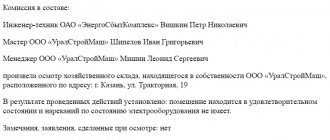Theft investigation technique
Theft is the secret theft of someone else's property (Part 1 of Article 158 of the Criminal Code of the Russian Federation). The qualifying features of which are the commission of theft by a group of persons by prior conspiracy; with illegal entry into the premises or other storage; causing significant damage to a citizen; from clothes, bags or other hand luggage that were with the victim (Part 2 of Article 158 of the Criminal Code of the Russian Federation). Theft with illegal entry into a home; from an oil pipeline, oil product pipeline, gas pipeline; on a large scale (Part 3 of Article 158 of the Criminal Code of the Russian Federation) or by an organized group; on an especially large scale (Part 4 of Article 158 of the Criminal Code of the Russian Federation).
The forensic characteristics of thefts include the following elements: a) the subject of the criminal offense and the method of committing the theft; b) the circumstances of the theft; c) the identity of the criminal; d) traces in a broad sense.
The objects of criminal encroachment are things of the material world that have property value and belong to individuals or legal entities by right of ownership. Moreover, some stolen items may have a variable physical state, for example, electrical or thermal energy. The subject of the criminal offense is closely interconnected with the method of committing thefts, since it determines the choice of the criminal’s system of actions to commit the crime. The method, in turn, may include actions to prepare and conceal the facts of theft. For example, theft from premises is mainly carried out subject to a preliminary inspection of locking devices or barriers, preparation of burglary tools, reconnaissance on the ground, etc. Pickpocketing also contains these elements, for example, tracking the victim, creating situations that distract the victim, etc. Concealing thefts can be expressed in the destruction of traces, the sale of stolen items, staging emergency situations (fire), etc.
The following common methods of theft :
1. Penetration into a dwelling (another room) by completely or partially destroying a barrier (knocking out doors, deforming a lock or locking mechanism, removing it from hinges, squeezing out double-glazed windows and disrupting the functions of window fittings, destroying part of a wall, ceiling, floor base.
2. Penetration into a home (other premises) without destroying a barrier, for example, selecting a key, working with a master key, possessing information about a hiding place with a key, free access through unlocked entrance doors, windows, balcony doors, vents.
3. The method of penetration of the criminal under the pretext of social services, provision of medical assistance with further identification by the criminal of places where the victim’s valuables are stored.
4. Secret theft of property in the clothes (pickpocketing), hand luggage (luggage) of the victim
Typical signs of theft . All traces identified at the scene of the theft can be divided into traces of the criminal
(prints of hands, bare feet, shoes, human biological secretions and microparticles);
traces of the crime weapon and their consequences
(traces of pressure, cutting, means of committing a crime, etc.).
Every trace identified at the scene of the theft is important, because in a system with other material formations it makes it possible to assume the mechanism of its leaving, which allows us to determine the method of committing the theft, and based on it, further identify the criminal.
The situation in which thefts occur is different and depends on the type of property, seasonality (for example, the holiday period or the end of the summer season is associated with theft of property from homes), time of day (for example, thefts from citizens’ apartments from 9 a.m. to 3 p.m. on weekdays and on weekends at night time). Pickpocketing occurs during rush hours in places with significant crowds of people (transport, markets, metro, cultural events).
The personality of a criminal is characterized by a criminal orientation towards committing illegal actions. Based on this, we can distinguish: a) “random” criminals who committed the theft of property left unattended. These persons do not have an established criminal background and rarely commit thefts; b) “situational” criminals, persons who adapt to different situations and act based on the situation. Unlike the first group, they have the intent to commit constant criminal acts (gypsies, minors from disadvantaged families, etc.); c) “professional” thieves, these include persons who have mastered a certain type of criminal trade, for example, “pickpockets”, “window burglars”, “safeguards”, etc.
Features of the initial stage of the investigation, investigative versions and situations.
For each statement or report of theft, a pre-investigation check is carried out within the time limits established by the Code of Criminal Procedure of the Russian Federation; if obvious signs of a crime and criminal circumstances of an encroachment on property rights are established, a criminal case is initiated without delay.
The material of the pre-investigation check includes: a protocol of an oral statement about the commission of a crime and an explanation of the victim; explanations of eyewitnesses and witnesses; accident scene inspection report; a report on the results of the pre-investigation check drawn up by the investigative body.
Typical investigative versions
: a) there was a theft; b) the applicant is mistaken, the fact of theft has not been confirmed; c) the theft was staged and the person was slandered.
Typical investigative situations.
Situation 1. Theft has taken place, the person who committed it has disappeared, there is no information about him . In this case, the following is carried out: a) interrogation of the victim; b) questioning of witnesses; c) inspection of the scene of the incident and the surrounding area; d) appointment of forensic examinations (traces, fingerprints, etc.); e) an order is given to the investigative bodies to identify the criminal and the stolen property.
Situation 2. The fact of theft has been established, information about the person involved in the crime is limited . In this case, the following is carried out: a) interrogation of the victim about the appearance of the suspected person; b) interrogation of witnesses and drawing up a verbal portrait of the criminal; c) inspection of the scene of the incident and the surrounding area; d) appointment of forensic examinations (traces, fingerprints, etc.); e) an order is given to the investigative bodies to identify the criminal and the stolen property.
Situation 3. The fact of theft occurs, the person is detained at the time (or after) the commission of the crime . In this case, it is more expedient to carry out: a) detention and personal search of the person; b) inspection of stolen items found in the possession of the criminal; c) examination (if there are grounds); d) interrogation of the suspect; e) search at the place of residence; f) interrogation of the victim and witnesses; g) appointment of forensic examinations.
Features of investigative tactics.
Features of the inspection of the scene include:
a) not only the premises are inspected, but also the surrounding area; b) it is necessary to establish the method and mechanism of entry into the premises, traces of the criminal and burglary tools, serviceability and condition of locking devices; c) resolve the issue of a possible staged theft, etc.; d) the inspection is carried out from the periphery to the center, or from the center to the periphery, for example, penetration by digging.
Forensic examinations. When investigating thefts, forensic examinations, microtrace examinations, forensic commodity examinations, and forensic chemical examinations are most often assigned.
Questions for self-control:
1. What are the features of initiating a criminal case. Give the circumstances to be established in cases of theft.
2. Reveal typical situations and a list of actions of the investigator at the initial stage of theft investigation.
3. What are the features of the tactics of initial and subsequent investigative actions in cases of theft?
4. What forensic examinations are ordered as part of an investigation into theft cases?
Recommended reading:
1. Protopopov A.L. Investigation of pickpocketing: monograph. - St. Petersburg: MIEP, 2011. 92 p.
2. Shmonin A.V. Methodology of forensic techniques: Monograph. -M.: Yurlitinform, 2010. -416 p.
3. Tskhovrebova I.A. Discussion problems of private methods of crime investigation // Theory and practice of criminology and forensic examination: Collection of scientific articles. Issue 2. M.: Academy of Management of the Ministry of Internal Affairs of Russia, 2007.
4. Alekseev S. Formation of criminal skill as a pattern of committing a crime by one person // Legality, 2011, No. 4
Theft is the secret theft of someone else's property (Part 1 of Article 158 of the Criminal Code of the Russian Federation). The qualifying features of which are the commission of theft by a group of persons by prior conspiracy; with illegal entry into the premises or other storage; causing significant damage to a citizen; from clothes, bags or other hand luggage that were with the victim (Part 2 of Article 158 of the Criminal Code of the Russian Federation). Theft with illegal entry into a home; from an oil pipeline, oil product pipeline, gas pipeline; on a large scale (Part 3 of Article 158 of the Criminal Code of the Russian Federation) or by an organized group; on an especially large scale (Part 4 of Article 158 of the Criminal Code of the Russian Federation).
The forensic characteristics of thefts include the following elements: a) the subject of the criminal offense and the method of committing the theft; b) the circumstances of the theft; c) the identity of the criminal; d) traces in a broad sense.
The objects of criminal encroachment are things of the material world that have property value and belong to individuals or legal entities by right of ownership. Moreover, some stolen items may have a variable physical state, for example, electrical or thermal energy. The subject of the criminal offense is closely interconnected with the method of committing thefts, since it determines the choice of the criminal’s system of actions to commit the crime. The method, in turn, may include actions to prepare and conceal the facts of theft. For example, theft from premises is mainly carried out subject to a preliminary inspection of locking devices or barriers, preparation of burglary tools, reconnaissance on the ground, etc. Pickpocketing also contains these elements, for example, tracking the victim, creating situations that distract the victim, etc. Concealing thefts can be expressed in the destruction of traces, the sale of stolen items, staging emergency situations (fire), etc.
The following common methods of theft :
1. Penetration into a dwelling (another room) by completely or partially destroying a barrier (knocking out doors, deforming a lock or locking mechanism, removing it from hinges, squeezing out double-glazed windows and disrupting the functions of window fittings, destroying part of a wall, ceiling, floor base.
2. Penetration into a home (other premises) without destroying a barrier, for example, selecting a key, working with a master key, possessing information about a hiding place with a key, free access through unlocked entrance doors, windows, balcony doors, vents.
3. The method of penetration of the criminal under the pretext of social services, provision of medical assistance with further identification by the criminal of places where the victim’s valuables are stored.
4. Secret theft of property in the clothes (pickpocketing), hand luggage (luggage) of the victim
Typical signs of theft . All traces identified at the scene of the theft can be divided into traces of the criminal
(prints of hands, bare feet, shoes, human biological secretions and microparticles);
traces of the crime weapon and their consequences
(traces of pressure, cutting, means of committing a crime, etc.).
Every trace identified at the scene of the theft is important, because in a system with other material formations it makes it possible to assume the mechanism of its leaving, which allows us to determine the method of committing the theft, and based on it, further identify the criminal.
The situation in which thefts occur is different and depends on the type of property, seasonality (for example, the holiday period or the end of the summer season is associated with theft of property from homes), time of day (for example, thefts from citizens’ apartments from 9 a.m. to 3 p.m. on weekdays and on weekends at night time). Pickpocketing occurs during rush hours in places with significant crowds of people (transport, markets, metro, cultural events).
The personality of a criminal is characterized by a criminal orientation towards committing illegal actions. Based on this, we can distinguish: a) “random” criminals who committed the theft of property left unattended. These persons do not have an established criminal background and rarely commit thefts; b) “situational” criminals, persons who adapt to different situations and act based on the situation. Unlike the first group, they have the intent to commit constant criminal acts (gypsies, minors from disadvantaged families, etc.); c) “professional” thieves, these include persons who have mastered a certain type of criminal trade, for example, “pickpockets”, “window burglars”, “safeguards”, etc.
Features of the initial stage of the investigation, investigative versions and situations.
For each statement or report of theft, a pre-investigation check is carried out within the time limits established by the Code of Criminal Procedure of the Russian Federation; if obvious signs of a crime and criminal circumstances of an encroachment on property rights are established, a criminal case is initiated without delay.
The material of the pre-investigation check includes: a protocol of an oral statement about the commission of a crime and an explanation of the victim; explanations of eyewitnesses and witnesses; accident scene inspection report; a report on the results of the pre-investigation check drawn up by the investigative body.
Typical investigative versions
: a) there was a theft; b) the applicant is mistaken, the fact of theft has not been confirmed; c) the theft was staged and the person was slandered.
Typical investigative situations.
Situation 1. Theft has taken place, the person who committed it has disappeared, there is no information about him . In this case, the following is carried out: a) interrogation of the victim; b) questioning of witnesses; c) inspection of the scene of the incident and the surrounding area; d) appointment of forensic examinations (traces, fingerprints, etc.); e) an order is given to the investigative bodies to identify the criminal and the stolen property.
Situation 2. The fact of theft has been established, information about the person involved in the crime is limited . In this case, the following is carried out: a) interrogation of the victim about the appearance of the suspected person; b) interrogation of witnesses and drawing up a verbal portrait of the criminal; c) inspection of the scene of the incident and the surrounding area; d) appointment of forensic examinations (traces, fingerprints, etc.); e) an order is given to the investigative bodies to identify the criminal and the stolen property.
Situation 3. The fact of theft occurs, the person is detained at the time (or after) the commission of the crime . In this case, it is more expedient to carry out: a) detention and personal search of the person; b) inspection of stolen items found in the possession of the criminal; c) examination (if there are grounds); d) interrogation of the suspect; e) search at the place of residence; f) interrogation of the victim and witnesses; g) appointment of forensic examinations.
Features of investigative tactics.
Features of the inspection of the scene include:
a) not only the premises are inspected, but also the surrounding area; b) it is necessary to establish the method and mechanism of entry into the premises, traces of the criminal and burglary tools, serviceability and condition of locking devices; c) resolve the issue of a possible staged theft, etc.; d) the inspection is carried out from the periphery to the center, or from the center to the periphery, for example, penetration by digging.
Forensic examinations. When investigating thefts, forensic examinations, microtrace examinations, forensic commodity examinations, and forensic chemical examinations are most often assigned.
Questions for self-control:
1. What are the features of initiating a criminal case. Give the circumstances to be established in cases of theft.
2. Reveal typical situations and a list of actions of the investigator at the initial stage of theft investigation.
3. What are the features of the tactics of initial and subsequent investigative actions in cases of theft?
4. What forensic examinations are ordered as part of an investigation into theft cases?
Recommended reading:
1. Protopopov A.L. Investigation of pickpocketing: monograph. - St. Petersburg: MIEP, 2011. 92 p.
2. Shmonin A.V. Methodology of forensic techniques: Monograph. -M.: Yurlitinform, 2010. -416 p.
3. Tskhovrebova I.A. Discussion problems of private methods of crime investigation // Theory and practice of criminology and forensic examination: Collection of scientific articles. Issue 2. M.: Academy of Management of the Ministry of Internal Affairs of Russia, 2007.
4. Alekseev S. Formation of criminal skill as a pattern of committing a crime by one person // Legality, 2011, No. 4
Concept
Pickpocketing is the most common form of property crime. The essence of the offense is the theft of the victim's property from pockets or carry-on luggage. The item can be any value: money, phones, wireless headsets, bank cards, jewelry.
Pickpocketing is a crime committed only with intent. In most cases, the motivation of a thief is personal enrichment: stealing money or an expensive item for the purpose of selling. However, some criminals commit crimes for the sake of adrenaline or entertainment. They are not so much interested in property as in the thirst for “thrills.” However, the motive does not negate the fact of theft, which means that it will not be possible to avoid responsibility for crimes of this kind.
Pickpocket Methods
There are many methods of pickpocketing. It is simply impossible to provide the entire list. In addition, law enforcement officers regularly encounter new and improved methods. Let's consider methods that are considered classics in practice.
Method number 1: distraction. Used by a group of thieves. They find a victim in the crowd, after which one of the attackers approaches the person with a trivial question. For example, with a request to tell you where an object is located. While the victim explains the way, the second attacker robs her. Finding such criminals is difficult.
Method number 2: hot tea. Can be used by one attacker. Instead of tea, there may be another hot drink or food that is guaranteed to stain the victim's clothes (for example, a hot dog with ketchup). The thief accidentally spills hot tea on a passerby or cafe visitor and, apologetically, rushes to help eliminate the consequences. But at this time deft hands are already examining pockets in search of valuables.
Method number 3: “Let me help you.” An offer to help grandma cross the road is not always good. For example, an attacker offers to help you down the steps. While you are going down, your pockets and purse are carefully examined for items of interest to the thief.
Method number 4: “Whose money?” Practiced in a group. One of the attackers throws a bill on the ground and addresses the victim, pointing out that she has lost money. While the victim is picking up the bills, an accomplice emerges from the crowd and claims that the money is his. While a person is arguing with an accomplice of a criminal, nothing prevents the thief from taking everything more or less valuable from his pockets.
There are also dozens of methods to remove a wallet from your pocket. The most common of them is practiced in transport or in a crowd. If a pickpocket notices that the edge of the victim's wallet is sticking out of his pocket, he calmly approaches her, grabs the wallet with two fingers and smoothly pulls it out, after which he slowly leaves.
Another method is also mainly used in crowds, especially in transport. The attacker approaches the victim from behind and positions himself near the pocket with the wallet. At the right moment, he gently pushes the wallet so that the edge of the wallet comes out of his pocket. The victim moves away, and the wallet, picked up by the pickpocket, remains in his hands.








